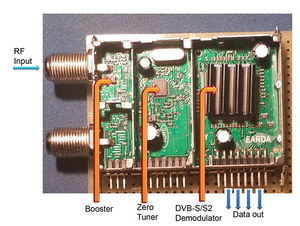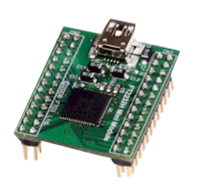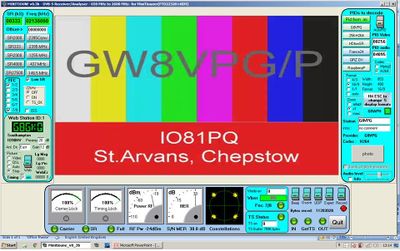MiniTioune
The MiniTioune receiver project, developed by Jean-Pierre F6DZP, consists of the home constructed MiniTiouner hardware which interfaces via a standard USB 2.0 port to a Windows PC running the MiniTioune software.
It will receive DVB-S QPSK and DVB-S2 QPSK, 8PSK, 16APSK, 32 APSK from broadcast and amateur TV transmissions with symbol rates (SR) from 30 Msymbols down to 120 Ksymbols per second.
It can be used to receive satellite broadcasts, "normal" DATV signals and is the ONLY system capable of receiving Reduced Bandwidth (RB-TV) transmissions.
Definitions
The following terms should be used when describing this project - note "MiniTiouner" is the French project name but maybe pronounced "Minituner" in English.
- MiniTioune = PC software
- MiniTiouner = The complete project hardware with USB interface - this can be prefixed with the type of tuner eg "Sharp Minitiouner"
Hardware overview
Full details of the MiniTiouner hardware and build information are available here
The NIM
The NIM or Network interface module is the little metal box found inside Satellite Receivers (also called the tuner) and typically contains 2 chips : the Zero Tuner and the Demodulator. RF Signal is sent to the antenna connector "RF input", it is amplified by a transistor "booster", the zero tuner selects the frequency asked and the demodulator extracts the data (Transport Stream) that goes outside the NIM on a digital parallel output.
The BATC shop used to sell a Sharp and Eardetek NIM with frequency coverage from 650 MHz through to 2600 MHz and so need an upconverter to receive 146 and 437 MHz. As of February 2017 the Sharp and Samsung tuners are no longer available and the project now uses a NIM tuner from Serit (model FTS4335) which covers from 143.75 MHz right through to 2450 MHz without the need for any upconverters.
This extended frequency coverage gives greater flexibility and means up converters from the VHF and UHF bands are not required and enables the 10 GHz band, including Es'HailSat-2 down link, to be received on a standard domestic PLL LNB. This makes building a receiver for 146 or 437 much easier, although you will need a pre-amp followed by lots of filtering for each band, just like the Sharp did, and probably followed by a Satellite line amp from ebay as the Serit has less gain than the Sharp.
However, due to a different pinouts from the Sharp NIM, the Serit FTS4335 NIM tuner will also need a simple adapter board to enable it to be plugged in to the MiniTiouner standard hardware - Brian G4EWJ has designed a board and these are available from the BATC shop. The adapter board and the Serit FTS4335 NIM tuner are available from the BATC shop.
Full details of this board and using the tuner are available here.
Note: As of April 2017 a new main PCB is being designed to directly take the Serit tuner - any new constructors should wait for the new board which will not need the adapter PCB. You only require the adaptor PCB if you are upgrading existing MiniTiouner hardware to include the Serit tuner. Check this page to work out if you should upgrade.
Note the project also worked with an earlier Serit tuner (SP2246) but none were sold by the BATC
USB module
The MiniTioune receive hardware is connected to a Windows PC running the MinITiouner software over a standard USB 2.0 port.
The pre-programmed USB module available from the BATC shop acts as a 2 channel USB converter between the PC USB port and the NIM. One channel is used for control and monitoring and the other carries the Transport stream data from the NIM.
PCB and Power supply
The rest of the MiniTiouner components provide the 1v, 3.3v and 5v supplies - these are mounted on the blank PCB supplied by the BATC shop.
So what do I need to buy?
The Minitiouner hardware is designed for home construction:
- The USB interface is available ready programmed from the BATC shop.
- The main PCB can be bought from the BATC shop. Note we are currently (April 2017) redesigning the board for one that will take the Serit tuner directly.
- Serit adapator PCB? See note above
- The tuner or NIM. The Serit unit covering 143 - 2450 MHz is available from the BATC shop
- SUP2400 70cms upconverter - The BATC shop sells this unit which is used to upconvert 146 and 70cms to L band. You do not need to buy it if you are using the Serit tuner.
All other components are available from normal suppliers.
Full details on how the build the MiniTiouner including a "how to video" and a zip file containing circuit diagram, layout and build instructions can be found on the MiniTiouner hardware wiki page. Please note the “full kit” mentioned in documentation is no longer available.
Band Pass filters
There is a whole section of the wiki dedicated to this most important part of your system - take a look at the pictures on the top of this page to see why you must use filters before your MiniTiouner!
Receive upconverters
The new Serit NIM FTS4335 covers 143.75 - 2450 MHz and does not require any external frequency converters.
As mentioned above, the Sharp tuner component (also called NIM) used in a MiniTiouner covers a maximum of 650 to 2600 MHz.
Whilst this is fine for the 23cms (1.3 GHz) and 13cms (2.3 GHz) amateur bands it does not provide coverage of 146 (2mts) and 437 MHz (70cms) where the majority of ATV operation takes place. Therefore we need to use an upconverter in front of the tuner which converts 146 MHz and 437 MHz up to an L band frequency that the MiniTiouner will receive.
A separate section on the wiki gives details of these upconverters.
Software
Full details of the MiniTioune software designed to be used with the MiniTiouner hardware are available here MiniTioune software.


